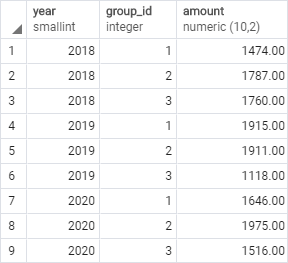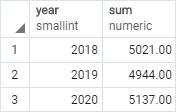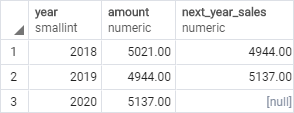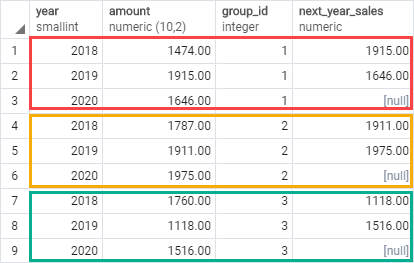Summary: in this tutorial, you will learn how to use the PostgreSQL LEAD() function to access a row that follows the current row, at a specific physical offset.
Introduction to PostgreSQL LEAD() function
PostgreSQL LEAD() function provide access to a row that follows the current row at a specified physical offset.
It means that from the current row, the LEAD() function can access data of the next row, the row after the next row, and so on.
The LEAD() function is very useful for comparing the value of the current row with the value of the row that following the current row.
The following illustrates the syntax of LEAD() function:
LEAD(expression [,offset [,default_value]])
OVER (
[PARTITION BY partition_expression, ... ]
ORDER BY sort_expression [ASC | DESC], ...
)
Code language: SQL (Structured Query Language) (sql)In this syntax:
expression
The expression is evaluated against the following row based on a specified offset from the current row. The expression can be a column, expression, subquery that must evaluate to a single value. And it cannot be a window function.
offset
The offset is a positive integer that specifies the number of rows forwarding from the current row from which to access data. The offset can be an expression, subquery, or column.
The offset defaults to 1 if you don’t specify it.
default_value
The default_value is the return value if the offset goes beyond the scope of the partition. The default_value defaults to NULL if you omit it.
PARTITION BY clause
The PARTITION BY clause divides rows into partitions to which the LEAD() function is applied.
By default, the whole result set is a single partition if you omit the PARTITION BY clause.
ORDER BY clause
The ORDER BY clause specifies the sort order of the rows in each partition to which the LEAD() function is applied.
PostgreSQL LEAD() function examples
Let’s set up a new table for the demonstration.
First, create a new table named sales:
CREATE TABLE sales(
year SMALLINT CHECK(year > 0),
group_id INT NOT NULL,
amount DECIMAL(10,2) NOT NULL,
PRIMARY KEY(year,group_id)
);
Code language: SQL (Structured Query Language) (sql)Second, insert some rows into the sales table:
INSERT INTO
sales(year, group_id, amount)
VALUES
(2018,1,1474),
(2018,2,1787),
(2018,3,1760),
(2019,1,1915),
(2019,2,1911),
(2019,3,1118),
(2020,1,1646),
(2020,2,1975),
(2020,3,1516);
Code language: SQL (Structured Query Language) (sql)Third, query data from the sales table:
SELECT * FROM sales;Code language: SQL (Structured Query Language) (sql)
1) Using PostgreSQL LEAD() function over a result set examples
The following query returns the total sales amount by year:
SELECT
year,
SUM(amount)
FROM sales
GROUP BY year
ORDER BY year;
Code language: SQL (Structured Query Language) (sql)
This example uses the LEAD() function to return the sales amount of the current year and the next year:
WITH cte AS (
SELECT
year,
SUM(amount) amount
FROM sales
GROUP BY year
ORDER BY year
)
SELECT
year,
amount,
LEAD(amount,1) OVER (
ORDER BY year
) next_year_sales
FROM
cte;
Code language: SQL (Structured Query Language) (sql)Here is the output:

In this example:
- First, the CTE returns the sales summarized by year.
- Then, the outer query uses the
LEAD()function to return the sales of the following year for each row.
The following example uses two common table expressions to return the sales variance between the current year and the next:
WITH cte AS (
SELECT
year,
SUM(amount) amount
FROM sales
GROUP BY year
ORDER BY year
), cte2 AS (
SELECT
year,
amount,
LEAD(amount,1) OVER (
ORDER BY year
) next_year_sales
FROM
cte
)
SELECT
year,
amount,
next_year_sales,
(next_year_sales - amount) variance
FROM
cte2;
Code language: SQL (Structured Query Language) (sql)
2) Using PostgreSQL LEAD() function over a partition example
The following statement uses the LEAD() function to compare the sales of the current year with sales of the next year for each product group:
SELECT
year,
amount,
group_id,
LEAD(amount,1) OVER (
PARTITION BY group_id
ORDER BY year
) next_year_sales
FROM
sales;
Code language: SQL (Structured Query Language) (sql)This picture shows the output:

In this example:
- The
PARTITION BYclause distributes rows into product groups (or partitions) specified by group id. - The
ORDER BYclause sorts rows in each product group by years in ascending order. - The
LEAD()function returns the sales of the next year from the current year for each product group.
In this tutorial, you have learned how to use the PostgreSQL LEAD() function to access a row at a specific physical offset which follows the current row.